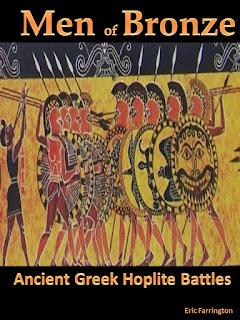 Herodotus tells us a great deal about the Ionian Revolt. Ionia was Greek colonies along the coast and edges of Turkey that had been captured and absorbed into the Persian Empire around 540 B.C.E. In 499 B.C.E the Tyrant of Miletus, Aristagoras; failed to capture the island of Naxos. This left him in a bad political position with his Persian overlords. In a desperate bid, he decided to stir revolt amongst his people against the Persians. This led many other local cities to cast off their Persian based Tyrants and replace them with Democracies.
Herodotus tells us a great deal about the Ionian Revolt. Ionia was Greek colonies along the coast and edges of Turkey that had been captured and absorbed into the Persian Empire around 540 B.C.E. In 499 B.C.E the Tyrant of Miletus, Aristagoras; failed to capture the island of Naxos. This left him in a bad political position with his Persian overlords. In a desperate bid, he decided to stir revolt amongst his people against the Persians. This led many other local cities to cast off their Persian based Tyrants and replace them with Democracies.
The Ionian Revolt had initial success in 498 B.C.E. when the allied Greek forces (including Athens, Eretria, and Ionians) managed to successfully attack Sardis. Sardis was the seat of a Persian Satrap and one of the personal enemies of Aristagoras. However, this minor victory was soon off-set by the Battle of Ephesus where Persian cavalry chased down and defeated the Greek forces.
Despite the loss, the revolt spread further. It spread to the Hellespont and Propontis. The city of the Carians also joined the revolt. In addition, Cyprus also revolted. Persian rule was in danger across the region, it was only a matter of time before the might of the Persian army would respond.
In 497 B.C.E., The Persian King had three generals appointed to put down the revolt. The three Persians (Daurises, Hymaees, and Otanes) divided the area into three partitions and attacked. Their attacks spread across the region. The battles and sieges for this period are largely unknown, with only a few details of the battles coming down to us from archeology and Herodotus.
Today’s battle will be one of those lost battles. Hymaees marched to the Propontis and attacked the city of Cius. Historically, he took the city. After his victory there he turned his attention towards the Hellespont and marched towards the Aeolian cities there. The Aeolian cities were 12 cities that formed a league. No record remains of what happened at these cities, only that Hymaees brought them back into the Persian fold. There is some confusion over which Persian general and which Persian armies took over which cities. However, for our purposes we will assume Hymaees was attacking the northern cities of the Aeolian League and the Troad and that these cities resisted with at least a token field force.
As Hymaees’ armies marched towards the city of Pergamon the defenders wisely fled behind their walls. However, the Persian general was wise to these tactics. He ordered his vanguard troops to ravage the fields and vineyards around the city in full view of the citizens within. Unsurprisingly, as his troops drew close to the precious fields the gates of Pergamon opened and their army came out to defend the fields.
The Forces
Few details remain of Hymaees’ campaigns near the Hellespont and the Troad. We only know that Hymaees re-took the Aeolian cities with his army while his fellow Persians attacked in other areas. Therefore, I will be using some standard armies from the Greek and Persian lists. The exact details of the true armies are not available.
Greeks
1 Drilled Hoplite
2 Militia Hoplites
3 Peltast
Persians
2 Archers
1 Drilled Infantry
2 Warband Infantry
1 Psiloi
The Greeks have 38 points, while the Persians have 30 points.
Deployment
This battle will be on a 6x4 board with both forces deployed on the long table edges. It will be using the scenario called Ravage the Countryside. In this scenario, the Greeks are trying to stop the Persians from destroying their fields and vineyards. The Persians need to get a unit into the field terrain and stay there for 1d3 turns. The Greeks must try to break the Persian force and keep them from the terrain.

The Greeks Deployed
The Greeks on the North side with the Persians coming from the South. The field is mostly flat, dusty plains with a few large boulders or rocky outcroppings. The Greeks are deploying in the Northeast corner of the board. The Persians are across the South, while the important fields are in the Northwest corner of the board.

Persian Left Flank with Greeks in the distance
You can read the outcome and full results at the Blog....
https://bloodandspectacles.blogspot.com/2018/04/battle-report-men-of-bronze-ravaging.html